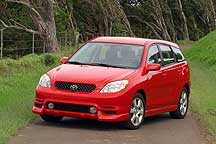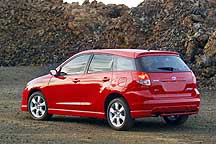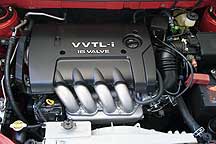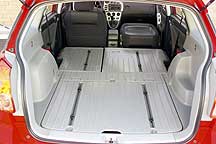
MSRP Range: $14,500 - $19,500
Invoice Range: $13,500 - $17,500
Price Quote
MSRP As Tested: $19,330
Versions: Standard, XR, XRS
Vehicle Category: Compact Sedan
Engine Location: Front Engine
Drive Wheels: Front-Wheel Drive or optional Four-Wheel Drive
Engine As Tested: 1.8-liter, Dual Overhead Cam, Inline 4-cylinder, 130-horsepower at 6,000 rpm and 125 lb-ft torque at 4,200 rpm. Optional - 1.8-liter, Dual Overhead Cam, Inline 4-cylinder, 180-horsepower at 7,600 rpm and 130 lb-ft torque at 6,800 rpm
Transmission As Tested: 5-Speed Manual. Optional 6-Speed Manual and 5-Speed Automatic
Fuel Economy (city/hwy): 130- horsepower/5-Speed Manual - 29/36, 180- horsepower/6-Speed Manual - 25/30, 130-horsepower/4-Speed Automatic - 28/33, 180- horsepower/4-Speed Automatic - 26/30
Standard Safety Features: Driver and Front Passenger, front airbags, front-wheel drum brakes and rear-wheel disc brakes
Competition: Chrysler PT Cruiser, Ford Focus, Honda Civic, Honda Element, Hyundai Elantra, Hyundai Sonata, Mazda Protege5, Pontiac Vibe (sister to the Matrix), Subaru Forester, Subaru Forester, Subaru Impreza, Subaru Outback, Volkswagen Golf, Volkswagen Jetta
Kona, HI -- One of the thorniest questions that buyers raise when car-buying crunch time arrives is how to reconcile their lifestyle needs with their fun and excitement desires.
When the minivans came along, just about twenty years ago, they were such an ideal layout that they just flew out of the dealerships. But quickly the public found that. along with the convenience. came a stodgy image. Sport utility vehicles exploded into our lives, but now their luster has been tarnished by their bulk, clumsiness and over-consumption of fuel and materials.
Hawaii is over run with small sedans and pickups, and vehicles like the Matrix fit right into the local lifestyle. With more and more of us aspiring to a tropical way of life, perhaps this could be the ideal vehicle, providing comfort, versatility, sportiness and all-wheel drive safety, all at an affordable price, along with economical and ecological driving behaviors.
Over the last five years, the public has flocked to aggressively styled, small sedans and wagon. Those with an all-wheel drive option have become especially popular, even if most folks ultimately purchase the 2-wheel drive versions.
As buyers have selected these multi-featured vehicles, they have created a new title: crossover utility vehicles. This is not a specific definition but rather a wide "lumping together" of products that don't fit in other categories. The Crossovers category includes sporty all-wheel drive sedans, sedan/sport utility vehicle combinations, station wagon/sports cars combos, sport ute/pickups mixes and even convertible sports car/pickups. Crossover is a "catch-all" , kind of like a dog's dinner, category and every automaker is trying to toss their product into the mix.
The current automotive climate is a complex one. Toyota has 23 vehicles in their competitive sphere. Buyers will cross-shop Matrix against vehicles like the Honda Civic, Ford Focus and Hyundai Elantra as well as the new crop of small SUVs and even sports cars.
Matrix arrives in February of 2003. It wil be built in Toyota's Cambridge, Ontario, Canada plant where the Corolla has been built since 1966. Matrix uses the same major components and engine family as does the Corolla. This only adds to the strength of the Toyota product line.
According to Takeshi Yoshida, Chief engineer for the Matrix, "Quality and reliability can be affordable. Toyota has provided thirty five years of this consistent message, and it has been the soul of every Toyota and Lexus." This market is filled with choices, the profits are small, but the segment is important to grab young buyers, sell them on corporate virtues, and retain them for life.
Mr. Yoshida has incorporated a more upscale interior, better performance and the lifestyle versatility that young people want. He has instituted what he calls the Oobeya open-office technique -- the major design and engineering staff all in one large space. This lessens formal communication lines, smooths development and identifies problems that occur during a product launch s before they become irreversible components of the design. Yoshida credits this technique with the shortening of the (industry leading) 24-month new-vehicle development cycle to 21-months. This provides a crucial advantage in a rapidly changing market. Oobeya is the newest version of the Kaizen management philosophy made famous by past Japanese products.

Toyota's West Coast design studio, CALTY, conceived the design, and used a sleek rendition of the four-door hatch layout for the greatest function, but solid street performance was the ultimate goal. Matrix styling is biased toward sport, while maintaining true utility. Its 'edge-web' detailing integrates sharp surface edges with rounded web-like contours to create bold yet flowing character lines. Matrix is their answer to supply youth's sports car appeal while not becoming obsolete when family pressures arise.
It comes in three grade levels, standard, XR, and XRS, each with a distinctive package of utility and performance, with front or all-wheel drive options and a lusty 180-horsepower in the XRS model. Matrix uses a dash mounted shifter, reminiscent of high performance rally cars, and this has the advantage of allowing space on the floor and between the seats for the accumulations of everyday life. Indications of the well thought out design are the user friendly exterior grab style door handles and the high mounted radio, both convenience and safety items that are often overlooked.

The all aluminum engine is carried over from the Corolla, but inches up to 130-horsepower versus the previous 125-horsepower, with a better torque curve. The XRS has the 2ZZ engine with a wider bore and shorter stroke, and incorporates Toyota's Variable Valve Timing with intelligence (VVTi) that uses oil pressure to change the cam angles in a linear fashion, optimizing efficiency.
There is a 6-speed manual transmission available on the XRS and 5-speed manuals and 4-speed automatics on all others, with better shifts due to tighter controls on the shift logic. The 4-Wheel Drive system is all-new for Toyota, and does not use a center differential. Viscous couplings on the rear input pinion senses any speed variation between front to rear differentials to balance traction in bad weather.
Proven strut suspension in the front and a twist beam rear layout on 2-Wheel Drive models with a double wishbone on 4-Wheel Drive versions combine with good size standard 16" wheels (17" is an option) provides a good ride, sure handling and larger brakes. With optional side air bags, solid structure and Isofix child seat restraint fittings, Toyota is ready for a five star rating.

The interior reflects Lexus quality standards for fit and finish yet is designed to offer the kind of interior function and flexibility consumers have come to expect in a sport utility vehicle. A CD player, rear defogger, and split folding seats are offered as standard, with the front passenger seat folding for longer items. To insure its flexibility, Matrix has flip up rear glass plus side and floor tie down points. There is a full size spare under the rear floor that allows maximum rear storage. And the console allows the optional GPS navigation system to be in a prominent, yet useful position. The excellent gauges on the test vehicles were a bit hard to read in the daytime due to their dark color and deep wells, but one benefit of the rapid change engineering effort is that they are promised to be changed by production delivery.
This broad grouping of vehicles is going to change rapidly, and may not ever get stabilized but that is the genius of Toyota and Oobeya. Matrix means "something within or from which something else originates, develops, or takes form." There's going to be a lot developing from the Matrix model. GM has partnered with Toyota on the Prizm sedan in the past, and now Pontiac has its version of the Matrix, called the Vibe. They have been part of the development process, and both companies benefit.
MORE DATA
Where Built: Cambridge, Ontario, Canada
Seating: 5
Number of Rows: 2
Crash Test Ratings for Front-Wheel Drive:
- NHTSA Frontal Impact/Driver Crash Test Rating: *****
- NHTSA Frontal Impact/Passenger Crash Test Rating: *****
- NHTSA Side Impact/Front Seat Crash Test Rating: Not Tested
- NHTSA Side Impact/Rear Seat Crash Test Rating: Not Tested
- NHTSA Rollover Resistance Rating: ****
- IIHS Frontal Offset Crash Test: Untested
Crash Test Ratings for All-Wheel Drive:
- NHTSA Frontal Impact/Driver Crash Test Rating: Not Tested
- NHTSA Frontal Impact/Passenger Crash Test Rating: Not Tested
- NHTSA Side Impact/Front Seat Crash Test Rating: *****
- NHTSA Side Impact/Rear Seat Crash Test Rating: ****
- NHTSA Rollover Resistance Rating: *****
- IIHS Frontal Offset Crash Test: Untested
Length in Inches: 171.3
Warranties: 3 years/36,000 miles bumper-to-bumper, 5 years/unlimited miles corrosion, 5 years/60,000 mile powertrain.
Weight in Pounds: Front-Wheel Drive - 2,679, Rear-Wheel Drive - 2,943
Towing Capacity in Pounds: 1,500
Gas Tank Capacity in Gallons: Front-Wheel Drive - 13.2, Rear-Wheel Drive - 11.9
Destination Charge: $485




